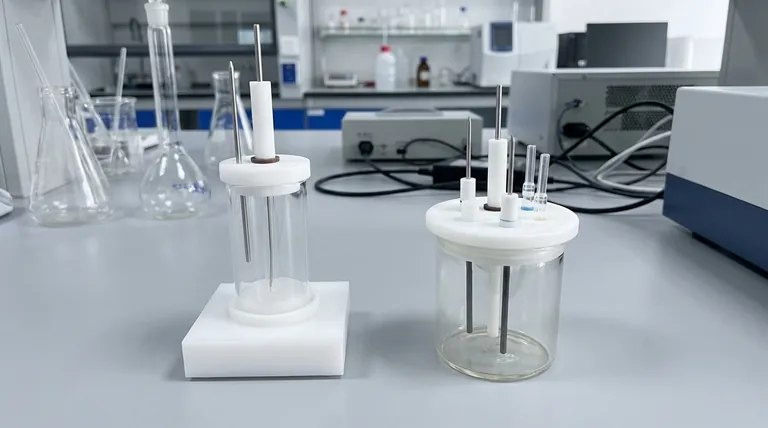For a standard all-quartz electrolytic cell, the specifications differ based on whether it is sealed or unsealed. An unsealed cell typically features three openings, each with a diameter of Φ6.2mm. A sealed cell provides more control and is equipped with five openings: three at Φ6.2mm and two smaller ones at Φ3.2mm.
The fundamental difference in design serves a specific purpose: sealed cells include smaller ports dedicated to gas inlets and outlets, enabling precise atmospheric control for sensitive experiments, while unsealed cells offer a simpler setup for general-purpose use.

Decoding the Standard Configuration
Understanding the purpose behind these standard openings is key to selecting the right equipment for your electrochemical experiment. The dimensions are not arbitrary; they are designed to accommodate standard components.
The Unsealed Cell: Simplicity and Accessibility
An unsealed cell is the most common configuration for basic electrochemistry.
Its standard setup consists of three openings, each with a diameter of Φ6.2mm. These are intended to hold the three essential electrodes: the working electrode, the counter electrode, and the reference electrode.
The Sealed Cell: Control and Precision
When an experiment is sensitive to oxygen or requires a specific gaseous atmosphere (like nitrogen or argon), a sealed cell is necessary.
This design typically has five openings. Three larger holes of Φ6.2mm are for the electrodes, just like the unsealed version.
Two additional, smaller holes of Φ3.2mm are included. These serve as gas inlets and outlets, allowing you to purge the cell and maintain an inert atmosphere throughout the experiment.
Understanding the Trade-offs and Variations
While these are the standard specifications, the choice between cell types and the possibility of customization depend entirely on your experimental needs.
Why Choose an Unsealed Cell?
Unsealed cells are ideal for routine experiments in aqueous solutions where atmospheric contamination is not a concern. They offer greater ease of use, faster setup, and are generally more accessible.
Why Choose a Sealed Cell?
A sealed cell is non-negotiable for any research involving air-sensitive materials, organic solvents that require a dry atmosphere, or experiments where a gaseous reactant is being studied. The ability to control the headspace is its primary advantage.
The Importance of Customization
Nearly all suppliers note that these standard configurations can be modified. If your setup involves non-standard electrodes, a Luggin capillary, a temperature probe, or other sensors, you can almost always request custom opening sizes and placements.
Making the Right Choice for Your Experiment
The specifications are a direct reflection of experimental requirements. Use your research goals to determine the best configuration.
- If your primary focus is standard aqueous electrochemistry: The 3-opening (Φ6.2mm) unsealed cell is the efficient and appropriate choice.
- If your primary focus is air-sensitive research or gas-phase studies: The 5-opening (3x Φ6.2mm, 2x Φ3.2mm) sealed cell is essential for valid results.
- If your primary focus involves unique electrode sizes or multiple probes: You should request a custom-configured cell tailored to your specific setup.
Ultimately, matching the cell's design to the demands of your experiment is the first step toward reliable and reproducible data.
Summary Table:
| Cell Type | Number of Openings | Opening Sizes | Primary Purpose |
|---|---|---|---|
| Unsealed | 3 | All Φ6.2mm | Basic electrochemistry; holds 3 electrodes (working, counter, reference) |
| Sealed | 5 | 3x Φ6.2mm, 2x Φ3.2mm | Air-sensitive experiments; allows for gas inlet/outlet and atmospheric control |
Ensure experimental precision with the right electrolytic cell.
Whether your research requires a standard unsealed cell for routine analysis or a custom-sealed cell for sensitive, atmospheric-controlled experiments, KINTEK has the solution. We specialize in high-quality lab equipment, including custom-configured all-quartz electrolytic cells, to meet the exact needs of your laboratory.
Contact KINTEK today to discuss your specific requirements and let our experts help you achieve reliable and reproducible results.
Visual Guide

Related Products
- Quartz Electrolytic Electrochemical Cell for Electrochemical Experiments
- H-Type Double-Layer Optical Electrolytic Electrochemical Cell with Water Bath
- Electrolytic Electrochemical Cell for Coating Evaluation
- Double Layer Five-Port Water Bath Electrolytic Electrochemical Cell
- H Type Electrolytic Cell Triple Electrochemical Cell
People Also Ask
- What are the available volumes and dimensions for the all-quartz electrolytic cell? Find the Perfect Fit for Your Lab
- What are the primary applications of the all-quartz electrolytic cell? Essential for High-Purity & Optical Analysis
- What are the necessary steps to prepare an all-quartz electrolytic cell before an experiment? Ensure Accuracy and Safety
- How should an all-quartz electrolytic cell and its components be maintained for long-term use? A Guide to Maximizing Equipment Lifespan
- What is the proper procedure for post-experiment cleanup and storage of an all-quartz electrolytic cell? Ensure Longevity and Reproducibility



















